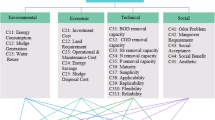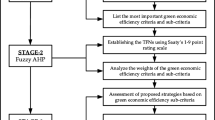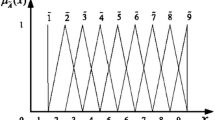Abstract
Background
Environmental policies should be developed in a contextual decision-making process regarding local environmental concerns emphasizing the economic, technical, social and institutional considerations. Establishing emission limit levels, especially in the industrial sector, is one of the most problematic environmental issues in developing countries, for which it is essential to include several criteria that reflect their country-specific constraints and capacities. Since Best Available Technology (BAT) is acknowledged to be the reference element for sustainable development and a basis for Emissions Limit Values (ELVs), the objective of this study is to present a reliable methodology for establishing ELVs thresholds with an emphasis on the BAT concept for national regulation at the sector level.
Methods
A hybrid fuzzy multiple-criteria decision-making (FMCDM) process, consisting of the Analytic Hierarchy Process (AHP) and fuzzy Technique for Order of Preference by Similarity to Ideal Solution (fuzzy TOPSIS) method, is structured to aggregate the different criteria and rank different ELV alternatives in this complicated evaluation. In order to use the most profound knowledge and judgment of a professional expert team, this qualitative assessment highlights the importance of supportive information.
Results
The results obtained indicate that experts have considered the country-specific information as a reliable reference in their decisions. Among different key evaluation criteria in effluent standard setting, the highest experts’ priority is “Environmental protection”. For both the conventional and toxic pollutants, the influence of all other criteria namely “Economic feasibility”, “Technology viability” and “Institutional capacity”, as constraining criteria in developing countries, have not reduced the responsibility towards the environmental objectives. In ELVs ranking, experts have made their decisions with respect to the specific characteristics of each pollutant and the existing capacities and constraints of the country, without emphasizing on any specific reference.
Conclusions
This systematic and transparent approach has resulted in defensible country-specific ELVs for the Iron and Steel industry, which can be developed for other sectors. As the main conclusion, this paper demonstrates that FMCDM is a robust tool for this comprehensive assessment especially regarding the data availability limitations in developing countries.


Similar content being viewed by others
Abbreviations
- BAT:
-
Best Available Technology
- ELVs:
-
Emissions Limit Values
- FMCDM:
-
Fuzzy Multiple-Criteria Decision-Making
- AHP:
-
Analytic Hierarchy Process
- Fuzzy TOPSIS:
-
Fuzzy Technique for Order of Preference by Similarity to Ideal Solution
- DOE:
-
Department of Environment
- ISESs:
-
Industry-Specific Effluent Standards
- EPA:
-
Environmental Protection Agency
- BPT:
-
Best Practicable Control Technology Currently Available (BPT)
- CVI:
-
Content Validity Index
- EU:
-
European Union
- IPPC:
-
Integrated Pollution Prevention and Control Directive
- BAT-AEL:
-
BAT associated emission level
- BPT-AEL:
-
BPT associated emission level
- BREFs:
-
BAT reference documents
- DMs:
-
Decision-Makers
- WTTs:
-
Wastewater Treatment Technologies
- DL:
-
Detection Limit
- TFNs:
-
Triangular Fuzzy Numbers
- FPIS:
-
Fuzzy Positive Ideal Solution
- FNIS:
-
Fuzzy Negative Ideal Solution
- RC:
-
Relative Closeness.
References
Gumus AT. Evaluation of hazardous waste transportation firms by using a two step fuzzy-AHP and TOPSIS methodology. Expert Syst Appl. 2009;36:4067–74.
EuropeanCommission: Directive 2010/75/EU of the European Parliament and of the Council of 24 November 2010 on industrial emissions (Integrated Pollution Prev Control). pp. 103: Off J Eur Union; 2010:103.
Giner-Santonja G, Aragonés-Beltrán P, Niclós-Ferragut J. The application of the analytic network process to the assessment of best available techniques. J Clean Prod. 2012;25:86–95.
Mavrotas G, Georgopoulou E, Mirasgedis S, Sarafidis Y, Lalas D, Hontou V, et al. An integrated approach for the selection of best available techniques (BAT) for the industries in the greater Athens area using multi-objective combinatorial optimization. Energy Econ. 2007;29:953–73.
Chakrabarti S, Mitra N. Economic and environmental impacts of pollution control regulation on small industries: a case study. Ecol Econ. 2005;54:53–66.
Bugallo PB, Andrade LC, Iglesias AM, López RT. Integrated environmental permit through best available techniques: evaluation of the fish and seafood canning industry. J Clean Prod. 2013;47:253–64.
Camisón C. Effects of coercive regulation versus voluntary and cooperative auto-regulation on environmental adaptation and performance: empirical evidence in Spain. Eur Manag J. 2010;28:346–61.
Testa F, Daddi T, De Giacomo MR, Iraldo F, Frey M. The effect of integrated pollution prevention and control regulation on facility performance. J Clean Prod. 2014;64:91–7.
Konterman I, Scheren P, Leuven R, Ragas A, Lubberding H, Niebeek G, et al. Environmental quality objective approach to effluent standards definition. A useful approach within the Developing Countries context. 2003;
Ragas A, Scheren P, Konterman H, Leuven R, Vugteveen P, Lubberding H, et al. Effluent standards for developing countries: combining the technology-and water quality-based approach. Water Sci Technol. 2005;52:133–44.
Kunz N, Moran C, Kastelle T. Conceptualising “coupling” for sustainability implementation in the industrial sector: a review of the field and projection of future research opportunities. J Clean Prod. 2013;53:69–80.
Tseng M-L, Tan RR, Siriban-Manalang AB. Sustainable consumption and production for Asia: sustainability through green design and practice. J Clean Prod. 2013;40:1–5.
Kim J, Kim HW, Shin J-S, Lee C-G, Chung M, Huh IA, et al. Implementation of the effluent limitations based on the best practicable control technology for the petroleum refining industry in Korea. Desalin Water Treat. 2013;52:145–55.
Frost R: EU practice in setting wastewater emission limit values. 2009.
Dijkmans R. Methodology for selection of best available techniques (BAT) at the sector level. J Clean Prod. 2000;8:11–21.
Polders C, Van den Abeele L, Derden A, Huybrechts D. Methodology for determining emission levels associated with the best available techniques for industrial waste water. J Clean Prod. 2012;29-30:113–21.
Derden A, Vercaemst P, Dijkmans R. Best available techniques (BAT) for the fruit and vegetable processing industry. Resour Conserv Recycl. 2002;34:261–71.
Geldermann J, Rentz O. The reference installation approach for the techno-economic assessment of emission abatement options and the determination of BAT according to the IPPC-directive. J Clean Prod. 2004;12:389–402.
Schollenberger H, Treitz M, Geldermann J. Adapting the European approach of best available techniques: case studies from Chile and China. J Clean Prod. 2008;16:1856–64.
Brechet T, Tulkens H. Beyond BAT: selecting optimal combinations of available techniques, with an example from the limestone industry. J Environ Manag. 2009;90:1790–801.
Samarakoon SMK, Gudmestad OT. The IPPC directive and technique qualification at offshore oil and gas installations. J Clean Prod. 2011;19:13–20.
Cikankowitz A, Laforest V. Using BAT performance as an evaluation method of techniques. J Clean Prod. 2013;42:141–58.
López-Gamero MD, Claver-Cortés E, Molina-Azorín JF. Evaluating environmental regulation in Spain using process control and preventive techniques. Eur J Oper Res. 2009;195:497–518.
Chung J, Kim J, Kim Y, Hwang Y. Assessment and selection of best available technology (BAT) for wastewater facilities in the leather tanning and finishing industry. Resour Conserv Recycl. 2013;70:32–7.
Behzadian M, Khanmohammadi Otaghsara S, Yazdani M, Ignatius J. A state-of the-art survey of TOPSIS applications. Expert Syst Appl. 2012;39:13051–69.
Kalbar PP, Karmakar S, Asolekar SR. The influence of expert opinions on the selection of wastewater treatment alternatives: a group decision-making approach. J Environ Manag. 2013;128:844–51.
Saaty TL. The analytic hierarchy process. New York: McGraw-Hill; 1980.
Aragones-Beltran P, Mendoza-Roca JA, Bes-Pia A, Garcia-Melon M, Parra-Ruiz E. Application of multicriteria decision analysis to jar-test results for chemicals selection in the physical-chemical treatment of textile wastewater. J Hazard Mater. 2009;164:288–95.
Tan RR, Aviso KB, Huelgas AP, Promentilla MAB. Fuzzy AHP approach to selection problems in process engineering involving quantitative and qualitative aspects. Process Saf Environ Prot. 2014;92:467–75.
Huang IB, Keisler J, Linkov I. Multi-criteria decision analysis in environmental sciences: ten years of applications and trends. Sci Total Environ. 2011;409:3578–94.
Hwang C-L, Yoon K. Multiple Attribute Decision Making: Methods and Applications. New York: Springer-Verlag; 1981.
Sadi-Nezhad S, Khalili Damghani K. Application of a fuzzy TOPSIS method base on modified preference ratio and fuzzy distance measurement in assessment of traffic police centers performance. Appl Soft Comput. 2010;10:1028–39.
Mardani A, Jusoh A, Zavadskas EK. Fuzzy multiple criteria decision-making techniques and applications – two decades review from 1994 to 2014. Expert Syst Appl. 2015;42:4126–48.
Chung ES, Kim Y. Development of fuzzy multi-criteria approach to prioritize locations of treated wastewater use considering climate change scenarios. J Environ Manag. 2014;146:505–16.
Kim Y, Chung E-S, Jun S-M, Kim SU. Prioritizing the best sites for treated wastewater instream use in an urban watershed using fuzzy TOPSIS. Resour Conserv Recycl. 2013;73:23–32.
Minatour Y, Bonakdari H, Zarghami M, Bakhshi MA. Water supply management using an extended group fuzzy decision-making method: a case study in North-Eastern Iran. Appl Water Sci. 2015;5:291–304.
Qu J, Meng X, Yu H, You H. A triangular fuzzy TOPSIS-based approach for the application of water technologies in different emergency water supply scenarios. Environ Sci Pollut Res. 2016;23:17277–86.
Onu UP, Xie Q, Xu L. A fuzzy TOPSIS model framework for ranking sustainable water supply alternatives. Water Resour Manag. 2017:1–15.
Ouyang X, Guo F, Shan D, Yu H, Wang J. Development of the integrated fuzzy analytical hierarchy process with multidimensional scaling in selection of natural wastewater treatment alternatives. Ecol Eng. 2015;74:438–47.
Hu W, Liu G, Tu Y. Wastewater treatment evaluation for enterprises based on fuzzy-AHP comprehensive evaluation: a case study in industrial park in Taihu Basin, China. Springer Plus. 2016;5:907.
Zhang X, Gao L, Barrett D, Chen Y. Evaluating water management practice for sustainable mining. Water. 2014;6:414–33.
Zyoud SH, Kaufmann LG, Shaheen H, Samhan S, Fuchs-Hanusch D. A framework for water loss management in developing countries under fuzzy environment: integration of fuzzy AHP with fuzzy TOPSIS. Expert Syst Appl. 2016;61:86–105.
World steel in figures 2017 [https://www.worldsteel.org/].
Bottero M, Comino E, Riggio V. Application of the analytic hierarchy process and the analytic network process for the assessment of different wastewater treatment systems. Environ Model Softw. 2011;26:1211–24.
Mahjouri M, Ishak MB, Torabian A, Manaf LA, Halimoon N, Ghoddusi J. Optimal selection of Iron and steel wastewater treatment technology using integrated multi-criteria decision-making techniques and fuzzy logic. Process Saf Environ Prot. 2017;107:54–68.
Mahjouri M, Ishak MB, Torabian A, Manaf LA, Halimoon N. Determining the best practicable control technology and its associated emission levels for Iron and steel industry in Iran. Resour Conserv Recycl. 2017;127:114–23.
EuropeanCommission: Commission Implementing Decision of 28 February 2012 establishing the best available techniques (BAT) conclusions under Directive 2010/75/EU of the European Parliament and of the Council on industrial emissions for iron and steel production. vol. 55. pp. 36: Off J Eur Union; 2012:36.
Environmental, Health, and Safety Guidelines for Integrated Steel Mills [http://www.ifc.org/wps/wcm/connect/topics_ext_content/ifc_external_corporate_site/ifc+sustainability/our+approach/risk+management/ehsguidelines].
Saaty TL, Shang JS. Group decision-making: head-count versus intensity of preference. Socio Econ Plan Sci. 2007;41:22–37.
Garcia-Cascales MS, Lamata MT. Multi-criteria analysis for a maintenance management problem in an engine factory: rational choice. J Intell Manuf. 2009;22:779–88.
Cochran JK, Chen H-N. Fuzzy multi-criteria selection of object-oriented simulation software for production system analysis. Comput Oper Res. 2005;32:153–68.
Karsak EE, Tolga E. Fuzzy multi-criteria decision-making procedure for evaluating advanced manufacturing system investments. Int J Prod Econ. 2001;69:49–64.
Lin H-Y, Hsu P-Y, Sheen G-J. A fuzzy-based decision-making procedure for data warehouse system selection. Expert Syst Appl. 2007;32:939–53.
Meixner O: Fuzzy AHP group Decis Anal and its application for the evaluation of energy sources. Institute of Marketing and Innovation Vienna, Austria 2009.
Acknowledgements
The authors would like to express their special thanks to all the experts who were involved in the survey for this research. Without their outstanding knowledge and experience along with their passionate participation and input, the survey could not have been successfully conducted. Also, the cooperation of Iran’s Department of Environment is highly appreciated.
Author information
Authors and Affiliations
Contributions
MM: prepared the initial proposal, inquired the data, conducted the statistical analysis, and wrote the draft. MB and AT: suggested the topic, commented on the proposal and methods, provided scientific support, edited and commented on the final draft. LA and NH: commented on the proposal and methods, supervised the research, edited and commented on the final draft. All authors read and approved the final manuscript.
Corresponding author
Ethics declarations
The authors declare that they have no competing interests.
Consent for publication
Not applicable.
Ethics approval and consent to participate
Not applicable.
Rights and permissions
About this article
Cite this article
Mahjouri, M., Ishak, M.B., Torabian, A. et al. An integrated methodology for establishing industrial effluent limits in developing countries: Iran as a case study. J Environ Health Sci Engineer 16, 181–192 (2018). https://doi.org/10.1007/s40201-018-0306-6
Received:
Accepted:
Published:
Issue Date:
DOI: https://doi.org/10.1007/s40201-018-0306-6




